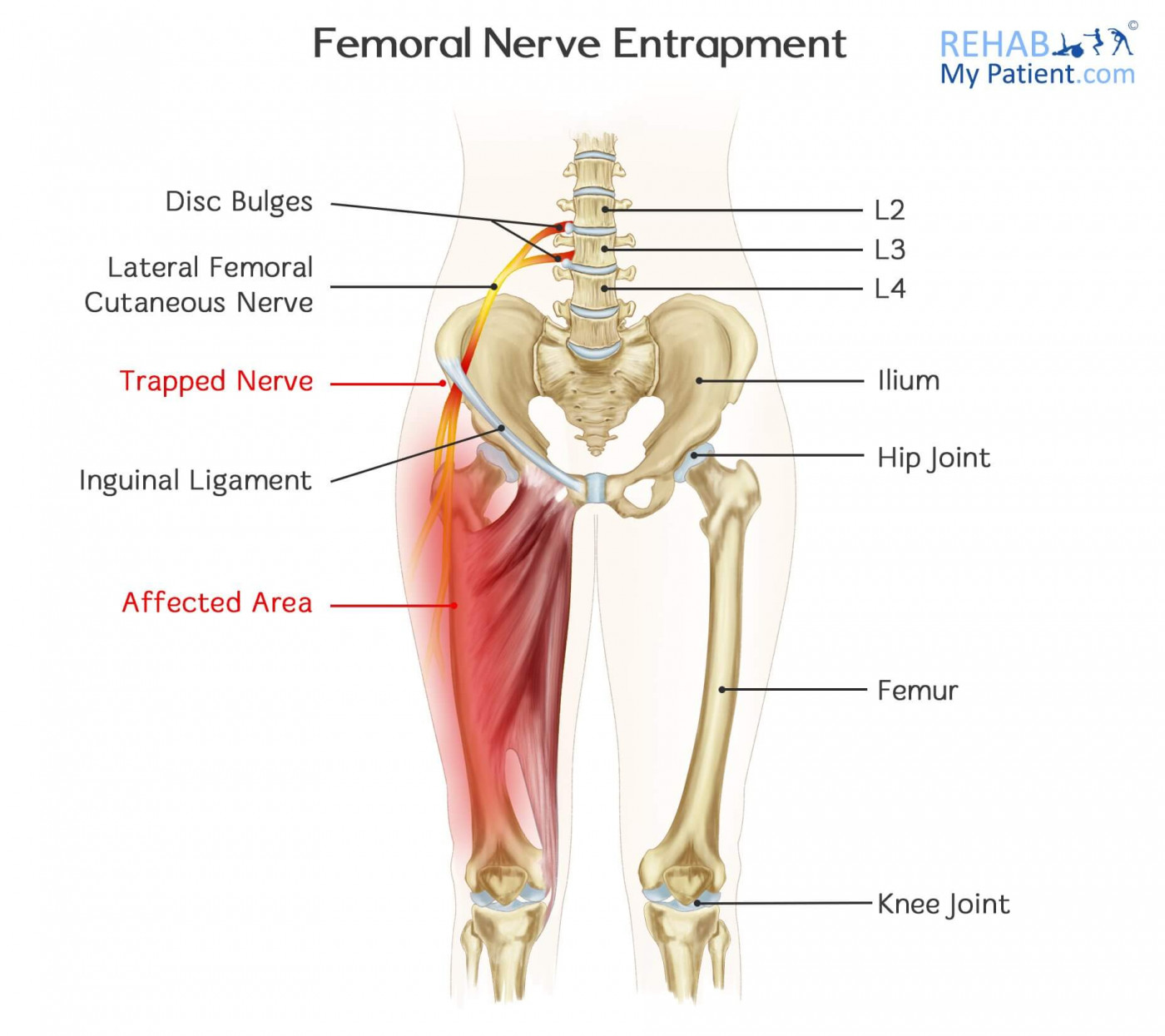
Femoral nerve entrapment is the pinching of the femoral nerve at some point along its course. Most often, that occurs at the spine. Pinching of the femoral nerve will cause pain, numbness or weakness felt in the front of the thigh.
Most of the time, the problem will end up going away without ever having to worry about getting any type of treatment, but that isn’t always the case. There are some instances where medications and therapies are used to help improve symptoms in individuals, especially if you have suffered with symptoms lasting longer than two weeks.
Causes of Femoral Nerve Entrapment
The most common cause is a disc prolapse at the L2/3 or L3/4 vertebra in the spine. As the disc bulges or prolapses backwards, it can hit the branch of the femoral nerve, causing symptoms into the front of the thigh. Degenerative change around the spine can also narrow the gap (foramen) where the nerve exits the spinal cord, and can pinch the femoral nerve. The femoral nerve is also commonly pinched in cases of hip arthritis, with patients often reporting pain travelling down the front of the thigh to the knee. Other causes can be anything which grows inside the body, such as a space occupying growth or tumour, but these are far less common.
If your therapist or consultant suspects a trapped nerve, they might suggest an MRI scan of the spine, or hip joint. This would show how badly the nerve is compressed, and any underlying issues. An MRI scan takes about 20-25 mins per region.
Femoral Nerve Entrapment Anatomy
Your femoral nerve runs from your spine right down into your hip area, and down the front of the leg. It is located near your groin and works to control all of the muscles that help to move your hips and straighten out your legs. Without this nerve, you wouldn’t be able to feel anything in the front of your thighs and along the lower part of your legs. If it ends up getting damaged, it causes you to struggle to walk. It could end up causing problems with your ability to feel in your foot and leg.
Surrounding the femoral nerve is femoral triangle, an anatomical landmark made up of other structures such as the inguinal ligament and iliopsoas tendon which can cause impingement of the nerve.

How to Treat Femoral Nerve Entrapment:
- Identify the Cause
The first thing you need to do is take the time to identify what caused the condition in the beginning. Is it linked with any back pain? Or are you noticing stiffness in your hip joint, or difficulty getting out of bed in the morning. As there are multiple causes, you should seek a manual therapist or doctor to investigate the potential cause.
- Medication
When the injury doesn’t get better on its own, you can turn to a corticosteroid injection to help reduce the swelling and inflammation in the area. Pain medication works to help relieve discomfort and pain. But before you try this, you should really try physical/manual therapy…
- Therapy
With the help of physical therapy, you can rebuild the strength within your muscles once again. You will go through a series of exercises to help stretch out your muscles and build strength in the affected areas. Using physical therapy, you can begin reducing the amount of pain you are dealing with and regain your range of movement. Usually the nerve will be “freed” from the spine, and what will follow is a reduction in leg symptoms. The nerve may also be mobilised by working into the groin muscles if the entrapment is here.
Tips:
- If you are diabetic, you need to get your blood sugar under control to prevent the condition from occurring in the first place.
- When getting ready to participate in any type of sporting event, spend time stretching out beforehand to prevent strain injuries.
- Don’t wait to begin treatment more than two weeks. Get to a medical expert ASAP to get the condition reviewed.
- Avoid standing or sitting for long periods of time. Get up and move around at least a few minutes every hour to keep the blood moving.
- An MRI scan of the spine might be helpful to identify how badly the nerve is trapped.
Sign Up
Sign up for your free trial now!
Get started with Rehab My Patient today and revolutionize your exercise prescription process for effective rehabilitation.
Start Your 14-Day Free Trial